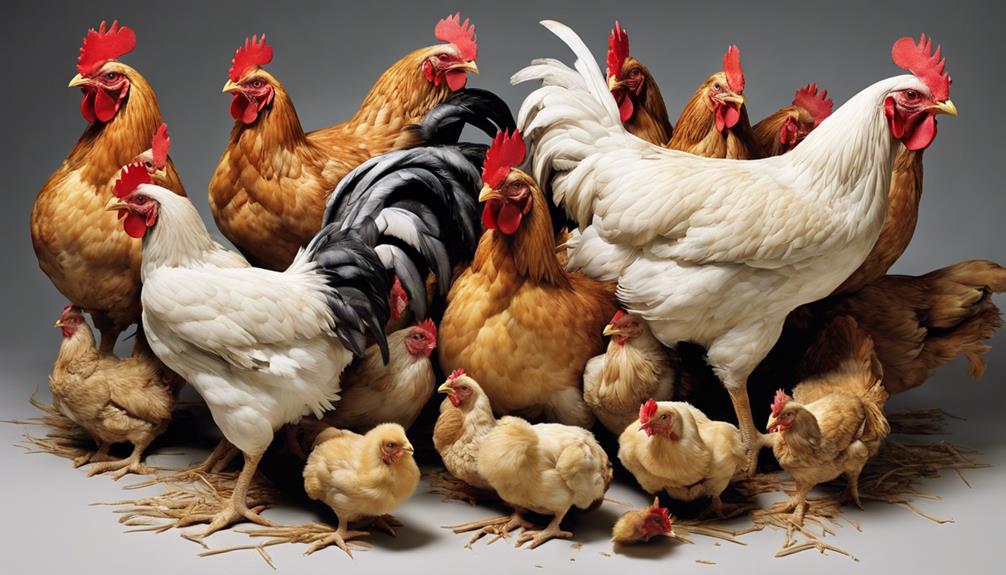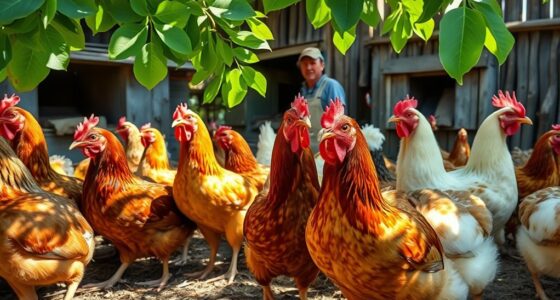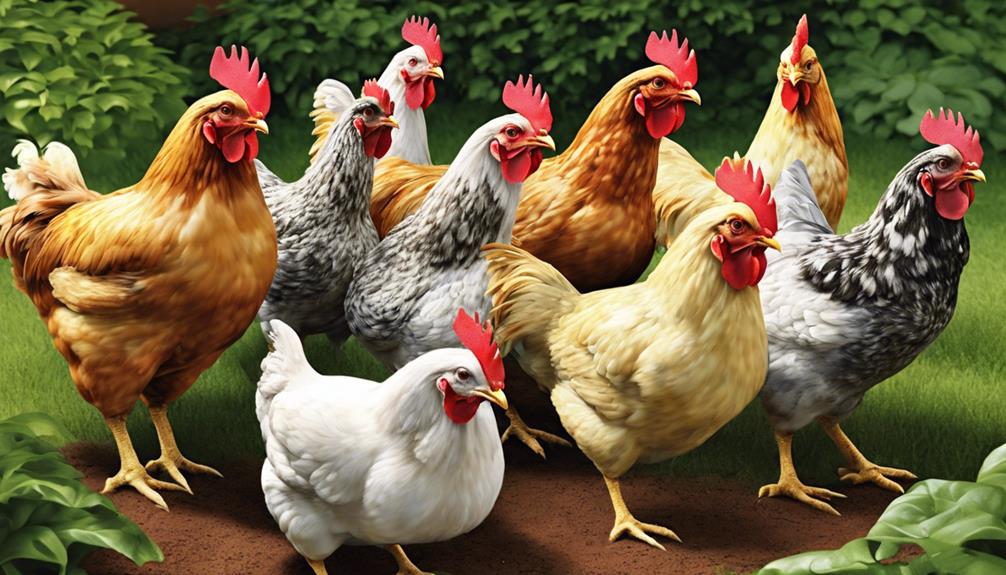To care for baby chicks, set up a spacious, draft-free brooder with clean bedding and maintain a temperature of around 95°F, lowering it gradually as they grow. Provide fresh water and high-protein starter feed multiple times daily, ensuring everything stays clean. Monitor their behavior, checking for signs of cold or overheating, and keep their environment safe and well-ventilated. With proper setup and attentive care, your chicks will thrive—learn more how to support their healthy development.
Key Takeaways
- Provide a clean, draft-free brooder with appropriate bedding and enough space for each chick.
- Maintain a consistent temperature starting at 95°F, gradually decreasing as chicks grow.
- Offer high-protein starter feed and fresh water at all times, ensuring cleanliness and accessibility.
- Monitor chick behavior for signs of discomfort, adjusting temperature and environment as needed.
- Regularly check for health issues and keep the brooder clean to promote healthy development.

Caring for baby chicks requires attention to their specific needs to guarantee healthy growth. One of the most important aspects is establishing a proper brooder setup. Your brooder should be a clean, warm, and safe environment that mimics their natural habitat. Start by choosing a sturdy container with enough space—at least 0.5 square feet per chick—to prevent overcrowding, which can lead to stress and health issues. Line the bottom with absorbent bedding like pine shavings, avoiding cedar shavings, which can be harmful. Keep the brooder in a draft-free area away from direct sunlight, and ensure it’s well-ventilated but not drafty. You’ll need a heat source, such as a heat lamp, positioned to maintain a temperature of about 95°F (35°C) during the first week. Gradually decrease the temperature by 5°F each week as the chicks grow, allowing them to regulate their body temperature comfortably. Monitoring their behavior is key—if they huddle under the heat source, it’s too cold; if they scatter away or pant, it’s too hot. Ensuring proper environmental conditions supports healthy development and provides safety from predators is essential for their well-being. Additionally, maintaining consistent temperature regulation helps prevent stress and promotes steady growth. Providing appropriate lighting can also influence their activity and feeding habits positively.
Feeding schedules are equally critical for healthy development. Baby chicks need a high-protein starter feed formulated specifically for their growth stage. Offer fresh, clean water at all times in a shallow dish to prevent drowning. You should refill their water multiple times daily and keep it clean to prevent the spread of disease. Establishing consistent feeding schedules helps chicks establish routines, which reduces stress and encourages eating. Typically, you’ll want to provide feed at least three to four times a day during their first few weeks. As they grow, you can gradually reduce feedings to twice a day, but always ensure they have access to water. Keep their feed and water containers clean and in easily accessible locations. Avoid sudden changes in diet or feed type, as this can upset their digestive systems. Regularly check on your chicks to ensure they’re active, warm, and eating well. Keep an eye out for signs of illness or distress, such as lethargy or abnormal droppings. Maintaining a clean brooder and consistent feeding schedule helps prevent infections and promotes healthy growth. As your chicks mature, you’ll adjust their environment and feeding routines accordingly, but the foundation—proper brooder setup and feeding schedules—sets the stage for strong, healthy birds. With attentive care, those tiny hatchlings will thrive, transforming into robust chickens ready for their next stage of life.
Frequently Asked Questions
When Should I Start Introducing Solid Food to My Chicks?
You should start introducing solid food to your chicks at about 3 to 4 days old, once they’re strong enough to peck. Keep their diet balanced with chick starter, which supports growth. While doing so, observe their nesting behavior and cage training to guarantee they’re comfortable. Always provide fresh water, and gradually mix in small amounts of solid food to encourage eating without overwhelming them.
How Can I Prevent My Chicks From Pecking Each Other?
Imagine a flock where pecking behavior and feather pecking threaten harmony. To prevent this, you should guarantee your chicks have enough space, avoid overcrowding, and provide enriching activities. Regularly monitor their behavior and separate aggressive birds early. Keep their environment clean and stress-free. By fostering a calm atmosphere and meeting their social needs, you can reduce pecking behavior and promote peaceful, healthy interactions among your chicks.
What Are Signs of Illness in Newly Hatched Chicks?
You should watch for signs of distress or symptoms of illness in your chicks, such as lethargy, labored breathing, or ruffled feathers. If they’re not eating or drinking, or if they have abnormal droppings, these could indicate health issues. Early detection helps you act quickly. Keep an eye on their activity levels and appearance, and consult a vet if you notice anything unusual to guarantee they stay healthy.
How Do I Handle a Chick That Is Not Drinking Water?
If a chick isn’t drinking water, you should first check its environment and guarantee the water is clean and easily accessible. Gently encourage chick hydration by dipping its beak into water or offering soaked feed. Monitor its water intake closely, as dehydration can quickly become serious. If it still refuses to drink, consult a vet promptly to prevent dehydration and ensure proper hydration, which is vital for its health and growth.
What Is the Best Way to Transition Chicks to Outdoor Living?
Think of outdoor living as a new adventure for your chicks. To facilitate a smooth outdoor acclimation, gradually introduce them to the fresh air and sunlight, starting with short periods. Always protect them from predators by using secure fencing and shelter. Over time, extend their outdoor hours, watching for signs they’re comfortable. This careful transition helps your chicks thrive outside, feeling safe and secure in their new environment.
Conclusion
Now that you’re caring for your tiny fluffballs, you’re basically a superhero in their eyes! With your help, these baby chicks will grow into majestic, feathered wonders that could fill a football stadium with their lively chirping. Keep them warm, fed, and loved, and you’ll witness a miraculous transformation from helpless hatchlings to proud, plucky farmyard legends. Your dedication transforms a tiny peep into a roaring symphony of clucks that could shake the entire barn!










